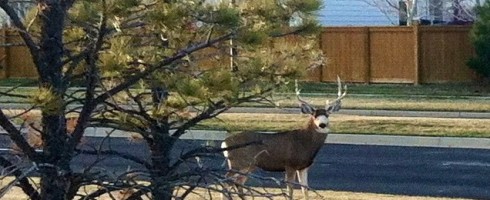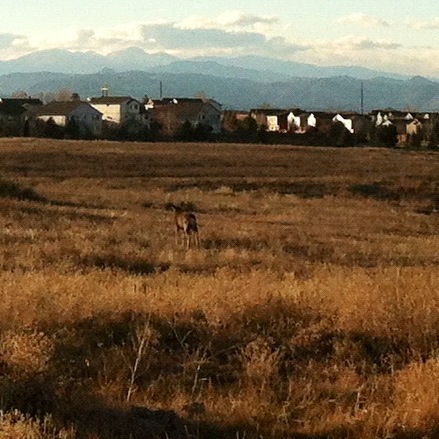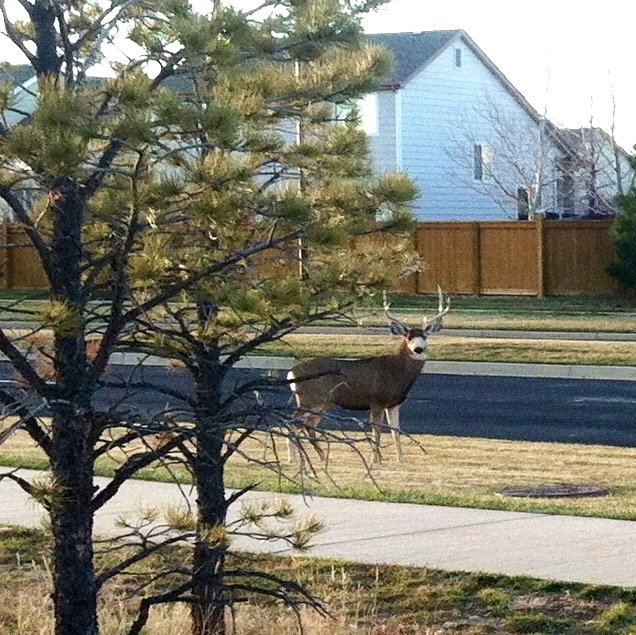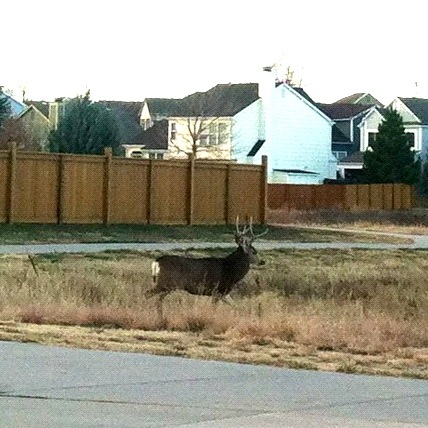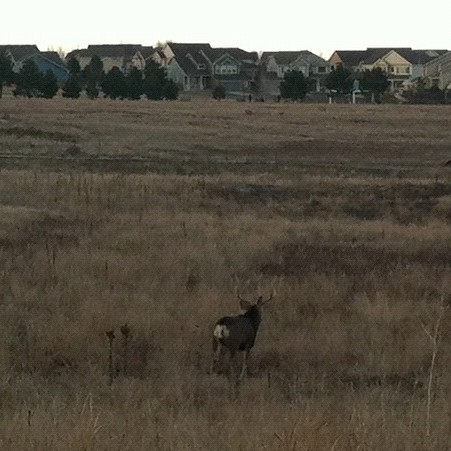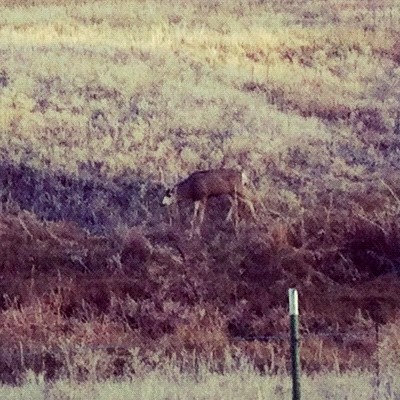By Renée Gotcher
This week NextGen Homeschool is joining forces with Creation Conversations and Kathy Balman @Kathy’s Cluttered Mind to bring you Wildlife Wednesday — posts about nature with a giveaway and a link up for your nature posts.
My family is an outdoor-loving family, and one of the reasons we feel truly blessed to call Colorado our home is the fact that we are exposed to such a variety of God’s magnificent creations right outside our doorstep — literally. It’s a wonderful opportunity to teach our three girls (11, 10 and 5) about nature without setting foot in a museum or zoo.
This past weekend, we had two close encounters with mule deer in our neighborhood. Mule deer are fairly common in our town’s shrub-covered hills, creek canyons, and open fields. Although not everyone enjoys their local residency (especially those with gardens to protect), my girls are delighted at every sighting. They are still in awe of these graceful, beautiful creatures living in our midst.
I was the first one to have a close encounter with a member of the local herd while running on a trail that starts at the end of our block and leads out into a creek canyon. I was joined by a tall mule deer buck with beautiful mature antlers who walked right across my trail into a nearby open space. He continued to meander in the same direction I was running, just a short distance away. I snapped quite a few pictures with my phone!
That very same evening, we were driving out of our neighborhood after sunset, heading out for last-minute holiday haircuts, when we saw another buck on the side of the road.
The girls were thrilled to see the buck, especially since they missed my earlier encounter. A split second later, my focus turned back to the road in front of me and sure enough — a deer in the headlights! I slowed down and honked, and the stunned doe finally sprung back into action and ran across the road to join her traveling companion.
Here’s where the education usually begins: Questions, questions, and more questions.
“Mom, why are there so many deer out right now?”
“Are they migrating? Are they looking for food since it’s snowing in the mountains?”
“Why do they freeze in the headlights like that?”
I realized that as many deer encounters as we’ve had as a family, we’d never taken the opportunity to get to know them better. These questions seemed like a great start, so here are the answers we found — as well as a few more fun facts we discovered:
Q: “Why are there so many deer out right now?”
A: Mule Deer are active primarily in mornings and evenings. They tend to stay in their specific home “range,” and when we see them often in the same place, it is probably because they are seasonal or full-time residents in our area. It’s November, so another reason we may be seeing a lot of them is that it’s the beginning of mating season.
Q: “Are they migrating? Are they looking for food since there’s snow in the mountains?”
A: Most mule deer with established home ranges and do not migrate until they are moving from an established winter territory (usually at lower, warmer elevations) to a summer territory (usually at higher, cooler elevations). Seasonal movements are usually a result of decreasing temperatures, snowstorms, snow depths and rainfall that reduce their mobility and availability of food. They usually travel back and forth between the same summer and winter territories.
Q: “Why are they called mule deer?”
A: Mule deer (Odocoileus hemionus) are identified by their large mule-like ears, which move constantly and independently and inspired the “mule” in their name. They are brownish-gray in color, have a white rump patch and a small white tail with a black tip. Their ear size and tails help distinguish them from another common deer, the white-tailed deer, which have smaller ears and larger bushy white tails.
Q: “How come only the bucks (males) grow antlers? When do they fall off?”
A: Adult males begin to grow antlers in spring, and they grow throughout the summer and fall. By November, the antlers are fully mature and ready to be used for establishing dominance between other bucks during breeding. Antlers are then shed in winter. The antlers of mule deer are distinct in that they split off from the main branch forming two evenly forked branches, each branch has 2 or more “tines.”
Q: “Do they always travel in herds?”
A: Bucks and does (females) tend to remain apart except in fall mating. After the breeding season, the deer live in small family groups of does, yearlings and the new fawns that are born. Bucks are usually solitary or live in small bachelor groups. Deer groups are likely to be spread out rather than in close association.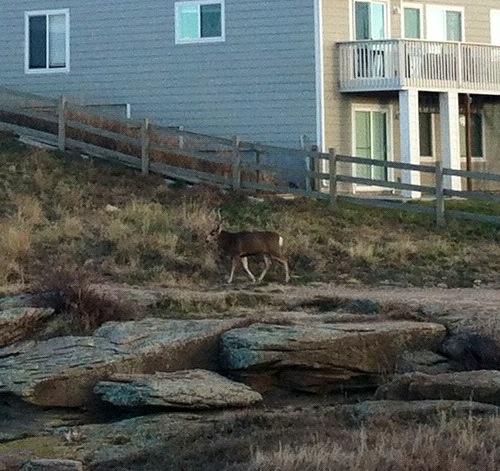
Q: “Where do they live, like in what countries?”
A: Although many species of deer can be found in many countries, Mule Deer live in North America, more commonly west of the Missouri River and in the Rocky Mountain region of North America. They are very adaptable and can be found in all of the biomes of western North America north of central Mexico, except the Arctic tundra. Mule Deer are found in coniferous forests, areas with small trees and shrubs, meadows and grasslands, and even deserts. They occupy any “edge” habitat, including suburban residential areas.
Q: “What do they eat?”
A: Mule Deer are herbivores and “browsers,” so they feed on woody vegetation, leaves of shrubs and trees, green plants, nuts, and twigs. They also forage on crops, especially corn, but eat very little grass, so they don’t compete with livestock or elk for food.
Q: “Why do they freeze in the headlights like that?”
A: Because deer activity peaks within an hour or so on either side of sunrise and sunset, their vision is optimized for very low light. So when a headlight beam strikes their fully dilated eyes, deer cannot see at all, and they freeze until the eyes can adjust. It is also believed that they can only see clearly at close range, much closer than the range of average human eyesight.
Did you know?
- Mule Deer are often called “mullies” (mule-ees).
- They are fast: Their distinctive bounding leap, a series of stiff-legged jumps called “stotting,” with all four feet hitting the ground together, allows them to reach speeds of up to 45 m.p.h.
- They have excellent hearing. Though they are probably well aware of your presence, mule deer often show little fear of humans.
- They are good swimmers, though they rarely use water as a means of escaping predators.
- They are 4-6 feet long, standing 3-3.5 feet high at the shoulder. Large bucks can weigh as much as 400 pounds, but does are only half that size.
- Their life span in the wild is approximately 10 years.
- Velvet covers the growing antlers and provides it with blood, supplying oxygen and other nutrients. The annual cycle of antler growth is regulated by changes in the length of the day.
- Females usually give birth to two fawns, although if it is their first time having a baby, they often only have one fawn.
Another activity I like to incorporate when learning about animals is to find out if they are mentioned in the Bible, and if so, in what context. We discovered that the mention of deer in the Bible is mostly poetic and metaphorical, reflecting an appreciation of their grace and beauty, as well as their natural abilities.
- Click here for a free PDF with Bible verses that mention the deer.
- Click here for a free PDF with instructions for a writing project I gave my daughters to incorporate what they learned about the deer into a short original poem. Here are their deer poetry examples from this assignment.
Lastly, my girls are lapbook lovers: No matter what subject matter they are learning about, they eventually want to make a lapbook about it. So I found a fabulous one at HomeschoolShare.com: Click here for free printable lapbook templates and resources on a study of deer.
We put the lapbook making on hold until we get back from our Thanksgiving week roadtrip to visit family in Oklahoma. In the meantime, the girls are looking forward to sharing what they’ve learned with their homeschooled cousins. Maybe we’ll get that lapbook started this week after all?
— Renée Gotcher is an entrepreneur, writer, wife & home-educating mother of three daughters: Audrey, Claire and Elise. Renée was homeschooled during her last two years of high school and started homeschooling in 2010. She is currently editor and lead author of NextGen Homeschool: Homeschooled Moms Homeschooling Our Next Generation. The Gotcher Family lives in Castle Rock, Colorado.

